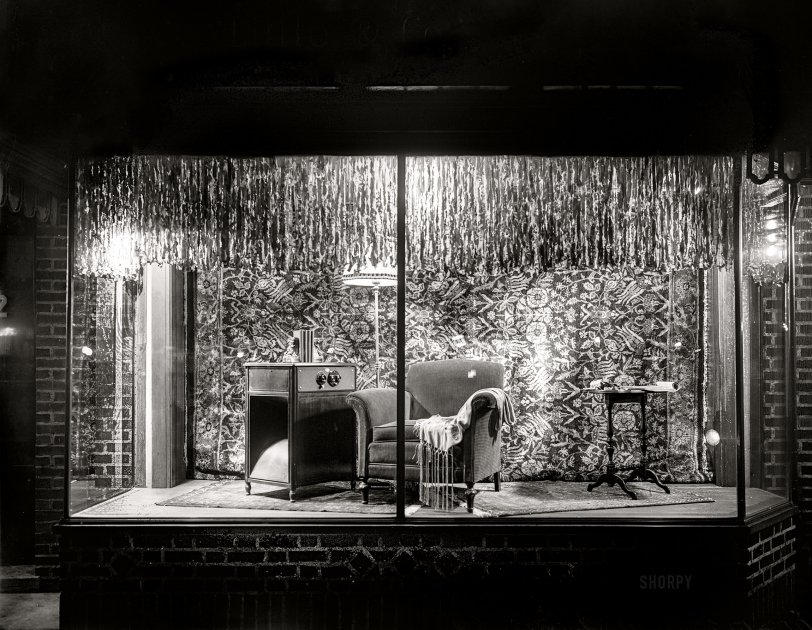


Framed or unframed, desk size to sofa size, printed by us in Arizona and Alabama since 2007. Explore now.
Shorpy is funded by you. Patreon contributors get an ad-free experience.
Learn more.

- Lofty addition
- In 1912
- Keenan Building
- Six years old
- Taken from the P.J. McArdle Roadway?
- It stood only 47 years
- Three track mind
- Incline to the right
- Reach for the sky, 1912 style
- No clean sweep
- Same Job Title, Same Face
- Sadly Lost
- Beautiful ...
- Where you get your kicks
- Aim High
- Pueblo Revival sisters
- Pueblo Neoclassicism
- Milk Man
- Regional dialect.
- Spielberg's inspiration
- Great Photo
- Loaf Story
- Do you still have the Rakes category?
- Could almost be a scene from the 1957 movie 'Hell Drivers'
- The Wages of Fear.
- Conspicuous by their absence
- Got Milk?
- All that aluminum
- No lefties
- Smoke 'em if you've got 'em
Print Emporium
Radio Noir: 1926

Washington, D.C., circa 1926. "Thos. R. Shipp Co. -- Atwater Kent window display at Little & Company, 13th & I Streets N.W." More specifically, the Atwater Kent Model 30 radio. National Photo Company glass negative. View full size.
Reflections in the glass
Many of the squares and other bright spots are reflections in the glass window. Note how some are doubled (such as the pair in front of the chair). Note also the car headlight reflecting off the lower-right part of the picture.
The Cabinet
The Radiomuseum learns that the cabinet is a Pooley Model 2000-R-2 "Arm Chair". It contained a powerful Pooley Amplifying Horn with AK driver, space for both "A" and "B" batteries and a charger, if desired. Beside this, there is a small drawer for tools, log card, etc.
In the Shorpy submission Atwater Kent: 1927 Mr. Atwater Kent himself was pictured standing by a Model 33 in a Pooley 1700-R-2 cabinet. the comments will give you a lot more information.
Spanish Shawl
Lying on the chair, one of the most popular accessories for the well-dressed flapper in the mid-1920's. Memorialized in a song titled, you guessed it, Spanish Shawl!
Hand-me-down chic
Strange to see anything in a prominent window display that looks like a large family after 12 years have just given their tattered belongings back to the store for consignment.
The radio has appeared in Shorpy before
The cabinet is an add-on feature: https://www.shorpy.com/node/4179
Rugged Radio
I think the backdrop is a rug because fringe is visible along the right side of the picture and the body of the design has a visible texture. Electric sound amplification was very new in 1926 and the sloping sound board was probably an Atwater Kent attempt to improve the broadcast volume. The right angle controls were likely to make chairside tuning easier.
Couple of things part 2
I believe the hollow end of the radio cabinet is the horn for the speaker. So cool in my opinion.
The backdrop
... definitely looks like a rug. The two little squares indeed appear to be a reflection to me. Look to the center left, you'll see two similar reflections. The hollowed out open part is what I assume to be a feature to improve acoustics.
Face your radio!
Isn't that speaker facing out toward the left? Sitting in the chair it would be radiating out to the window, wouldn't it?
Lots of Atwater Kent info here, but I haven't found that cabinet yet:
http://www.atwaterkentradio.com/index.htm
I love the history and quaintness of old radios but, like old cars, have no wish to own any!
Couple of things
First, is that busy busy busy backdrop actually a massive rug? Second, what are the two little squares on the chair? My instinct is to say a reflection but somehow that makes no sense to my eyes. Third, why does it look as though the radio's cabinet is hollow and open on one end, with an up-sloping part ... sorry I don't know how else to describe it. No I have not been imbibing unless you count sparkling water.
























On Shorpy:
Today’s Top 5